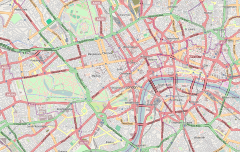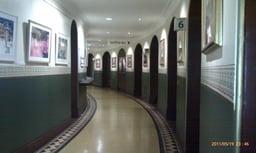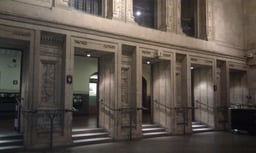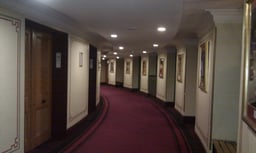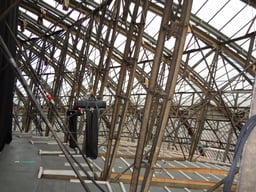Royal Albert Hall
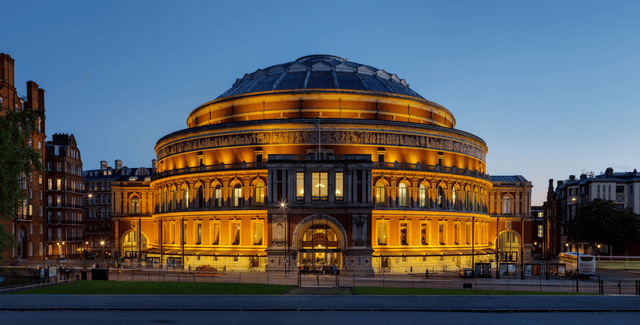
Royal Albert Hall

| Royal Albert Hall | |
|---|---|
 Interior viewed from the Grand Tier | |
| General information | |
| Type | Concert hall |
| Architectural style | Italianate |
| Address | Kensington Gore London, SW7 |
| Country | United Kingdom |
| Coordinates | 51°30′03.40″N 00°10′38.77″W [90] |
| Construction started | 18671 |
| Completed | 18711 |
| Inaugurated | 29 March 1871 (1871-03-29) |
| Renovated | 1996–2004 |
| Cost | £200,0001 |
| Client | Provisional Committee for the Central Hall of Arts and Sciences |
| Owner | The Corporation of the Hall of Arts and Sciences |
| Height | 135 feet (41 m) |
| Design and construction | |
| Architect | Captain Francis Fowke and Major-General Henry Y. D. Scott |
| Architecture firm | Royal Engineers |
| Main contractor | Lucas Brothers |
| Other information | |
| Seating capacity | 5,544 |
| Website | |
| royalalberthall.com [91] | |
| References | |
| 1– Victorian London: Royal Albert Hall 2– Royal Albert Hall, London [92] | |
The Royal Albert Hall is a concert hall on the northern edge of South Kensington, London. One of the United Kingdom's most treasured and distinctive buildings, it is a registered charity held in trust for the nation, as it receives no public or government funding.[1] It can seat 5,267.
Since the hall's opening by Queen Victoria in 1871, the world's leading artists from many performance genres have appeared on its stage. It is the venue for some of the most notable events in British culture, in particular the Proms concerts, which have been held there every summer since 1941. It is host to more than 390 shows in the main auditorium annually, including classical, rock and pop concerts, ballet, opera, film screenings with live orchestral accompaniment, sports, awards ceremonies, school and community events, and charity performances and banquets. A further 400 events are held each year in the non-auditorium spaces.
The hall was originally supposed to have been called the Central Hall of Arts and Sciences, but the name was changed to the Royal Albert Hall of Arts and Sciences by Queen Victoria upon laying the Hall's foundation stone in 1867, in memory of her husband, Prince Albert, who had died six years earlier. It forms the practical part of a memorial to the Prince Consort; the decorative part is the Albert Memorial directly to the north in Kensington Gardens, now separated from the Hall by Kensington Gore.
| Royal Albert Hall | |
|---|---|
 Interior viewed from the Grand Tier | |
| General information | |
| Type | Concert hall |
| Architectural style | Italianate |
| Address | Kensington Gore London, SW7 |
| Country | United Kingdom |
| Coordinates | 51°30′03.40″N 00°10′38.77″W [90] |
| Construction started | 18671 |
| Completed | 18711 |
| Inaugurated | 29 March 1871 (1871-03-29) |
| Renovated | 1996–2004 |
| Cost | £200,0001 |
| Client | Provisional Committee for the Central Hall of Arts and Sciences |
| Owner | The Corporation of the Hall of Arts and Sciences |
| Height | 135 feet (41 m) |
| Design and construction | |
| Architect | Captain Francis Fowke and Major-General Henry Y. D. Scott |
| Architecture firm | Royal Engineers |
| Main contractor | Lucas Brothers |
| Other information | |
| Seating capacity | 5,544 |
| Website | |
| royalalberthall.com [91] | |
| References | |
| 1– Victorian London: Royal Albert Hall 2– Royal Albert Hall, London [92] | |
History
1800s
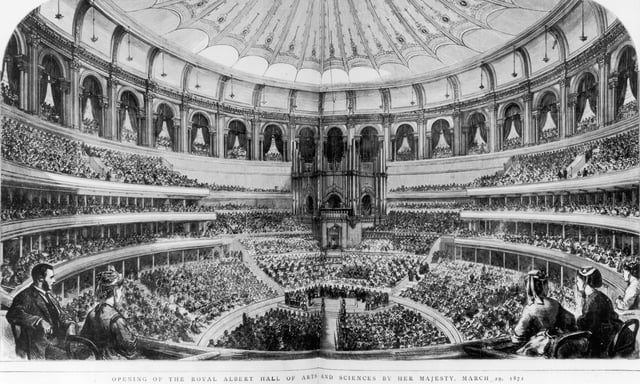
The first performance at the Hall. The decorated canvas awning is seen beneath the dome.

Acoustic diffusing discs (lit in purple/blue) hanging from the roof of the Hall. The fluted aluminium panels are seen behind.
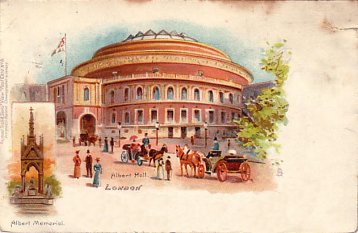
Postcard of the Hall (circa 1903) with an inset of the Albert Memorial
In 1851, the Great Exhibition (for which the Crystal Palace was built) was held in Hyde Park, London. The exhibition was a great success and led Prince Albert, the Prince Consort, to propose the creation of a permanent series of facilities for the enlightenment of the public in the area, which came to be known as Albertopolis. The Exhibition's Royal Commission bought Gore House and its grounds (on which the Hall now stands) on the advice of the Prince. Progress on the scheme was slow and in 1861 Prince Albert died, without having seen his ideas come to fruition. However, a memorial was proposed for Hyde Park, with a Great Hall opposite.
The proposal was approved and the site was purchased with some of the profits from the Exhibition. Once the remaining funds had been raised, in April 1867 Queen Victoria signed the Royal Charter of the Corporation of the Hall of Arts and Sciences which was to operate the Hall and on 20 May, she laid the foundation stone.[2] The Hall was designed by civil engineers Captain Francis Fowke and Major-General Henry Y. D. Scott of the Royal Engineers and built by Lucas Brothers.[3] The designers were heavily influenced by ancient amphitheatres, but had also been exposed to the ideas of Gottfried Semper while he was working at the South Kensington Museum. The recently opened Cirque d'Hiver in Paris was seen in the contemporary press as the design to outdo. The Hall was constructed mainly of Fareham Red brick, with terra cotta block decoration made by Gibbs and Canning Limited of Tamworth. The dome (designed by Rowland Mason Ordish) was made of wrought iron and glazed. There was a trial assembly made of the dome's iron framework in Manchester, then it was taken apart again and transported to London via horse and cart. When the time came for the supporting structure to be removed from the dome after reassembly in situ, only volunteers remained on site in case the structure collapsed. It did drop – but only by five-sixteenths of an inch.[4] The Hall was scheduled to be completed by Christmas Day 1870 and the Queen visited a few weeks beforehand to inspect.[5]
The official opening ceremony of the Hall was on 29 March 1871. A welcoming speech was given by Edward, the Prince of Wales; Queen Victoria was too overcome to speak. At some point, the Queen remarked the Hall reminded her of the British constitution.[2]
In the concert that followed, the Hall's acoustic problems became immediately apparent. Engineers first attempted to solve the strong echo by suspending a canvas awning below the dome. This helped and also sheltered concertgoers from the sun, but the problem was not solved: it used to be jokingly said the Hall was "the only place where a British composer could be sure of hearing his work twice".
In July 1871, French organist Camille Saint-Saëns performed Church Scene from Faust by Charles Gounod, The Orchestra described his performance as "an exceptional and distinguished performer ... the effect was most marvellous."
Initially lit by gas, the Hall contained a special system where its thousands of gas jets were lit within ten seconds. Though it was demonstrated as early as 1873 in the Hall,[6] full electric lighting was not installed until 1888.[2] During an early trial when a partial installation was made, one disgruntled patron wrote to The Times, declaring it to be "a very ghastly and unpleasant innovation".
In May 1877, Richard Wagner himself conducted the first half of each of the eight concerts which made up the Grand Wagner Festival. After his turn with the baton he handed it over to conductor Hans Richter and sat in a large arm chair on the corner of the stage for the rest of each concert. Wagner's wife Cosima, the daughter of Hungarian virtuoso pianist and composer Franz Liszt, was among the audience.
1900s
In 1906 Elsie Fogerty founded the Central School of Speech and Drama at the Hall, using its West Theatre, now the Elgar Room as the School's theatre. The School moved to Swiss Cottage in north London in 1957. Whilst the School was based at the Royal Albert Hall students who graduated from its classes included Judi Dench, Vanessa Redgrave, Lynn Redgrave, Harold Pinter, Laurence Olivier and Peggy Ashcroft.[9]
In 1911 Russian pianist and composer Sergei Rachmaninoff performed as a part of the London Ballad Concert. The recital included his 'Prelude in C-sharp minor' and 'Elegie in E-flat minor' (both from Morceaux de fantaisie).[10]
In 1933 German physicist Albert Einstein led the 'Einstein Meeting' at the hall for the Council for Assisting Refugee Academics; a British charity.[11]
In 1936, the Hall was the scene of a giant rally celebrating the British Empire on the occasion of the centenary of Joseph Chamberlain's birth. In October 1942, the Hall suffered minor damage during World War II bombing, but in general was left mostly untouched as German pilots used the distinctive structure as a landmark.[6]
In 1949 the canvas awning was removed and replaced with fluted aluminium panels below the glass roof, in a new attempt to solve the echo; but the acoustics were not properly tackled until 1969 when large fibreglass acoustic diffusing discs (commonly referred to as "mushrooms" or "flying saucers") were installed below the ceiling.[2] In 1968, the Hall hosted the Eurovision Song Contest 1968[12] and in 1969–1989, the Miss World contest was staged in the venue.[13]
From 1996 until 2004, the Hall underwent a programme of renovation and development supported by a £20 million grant from the Heritage Lottery Fund and £20m from Arts Council England °to enable it to meet the demands of the next century of events and performances. Thirty "discreet projects" were designed and supervised by architecture and engineering firm BDP without disrupting events. These projects included improved ventilation to the auditorium, more bars and restaurants, improved seating, better technical facilities and improved backstage areas. Internally, the Circle seating was rebuilt during June 1996 to provide more leg room, better access and improved sight lines.[14]
2000s
The largest project of the ongoing renovation and development was the building of a new south porch – door 12, accommodating a first floor restaurant, new ground floor box office and below ground loading bay. Although the exterior of the building was largely unchanged, the south steps leading down to Prince Consort Road were demolished to allow construction of an underground vehicle access and loading bay with accommodation for 3 HGVs carrying all the equipment brought by shows. The steps were then reconstructed around a new south porch, named The Meitar Foyer after a significant donation from Mr & Mrs Meitar. The porch was built in a similar scale and style to the three pre-existing porches at Door 3, 6 and 9: these works were undertaken by Taylor Woodrow Construction.[14] The original steps featured in early scenes of 1965 film The Ipcress File. On 4 June 2004, the project received the Europa Nostra Award for remarkable achievement.[15] The East (Door 3) and West (Door 9) porches were glazed and new bars opened along with ramps to improve disabled access. The Stalls were rebuilt in a four-week period in 2000 using steel supports allowing more space underneath for two new bars. 1534 unique pivoting seats were laid – with an addition of 180 prime seats. The Choirs were rebuilt at the same time. The whole building was redecorated in a style that reinforces its Victorian identity. 4000sqm of new carpets were laid in the rooms, stairs and corridors – specially woven with a border that follows the oval curve of the building.[16]
Between 2002 and 2004, there was a major rebuilding of the great organ (known as the Voice of Jupiter),[17] built by "Father" Henry Willis in 1871 and rebuilt by Harrison & Harrison in 1924 and 1933. The rebuilding was performed by Mander Organs[18] and it is now the second largest pipe organ in the British Isles with 9,997 pipes in 147 stops. The largest is the Grand Organ in Liverpool Cathedral which has 10,268 pipes.[19]
2010s
2011
During the first half of 2011, changes were made to the backstage areas to relocate and increase the size of crew catering areas under the South Steps away from the stage and create additional dressing rooms nearer to the stage.[20]
2012
During the summer of 2012 the staff canteen and some changing areas were expanded and refurbished by contractor 8Build.[21]
2013

The Royal Albert Hall as seen from Prince Consort Road
From January to May the Box Office area at Door 12 underwent further modernisation to include a new Café Bar on the ground floor, a new Box Office with shop counters and additional toilets. The design and construction was carried out by contractor 8Build. Upon opening it was renamed 'The Zvi and Ofra Meitar Porch and Foyer.' owing to a large donation from the couple.[22]
In Autumn 2013, work began on replacing the Victorian steam heating system over three years and improving and cooling across the building. This work follows the summer Proms season during which temperatures were particularly high.[23]
2014
From January the Cafe Consort on the Grand Tier was closed permanently in preparation for a new restaurant at a cost of £1 million. The refurbishment, the first in around 10 years, was designed by consultancy firm Keane Brands and carried out by contractor 8Build.[24] Verdi – Italian Kitchen was officially opened on 15 April with a lunch or dinner menu of 'stone baked pizzas, pasta and classic desserts'[25][26]
Design
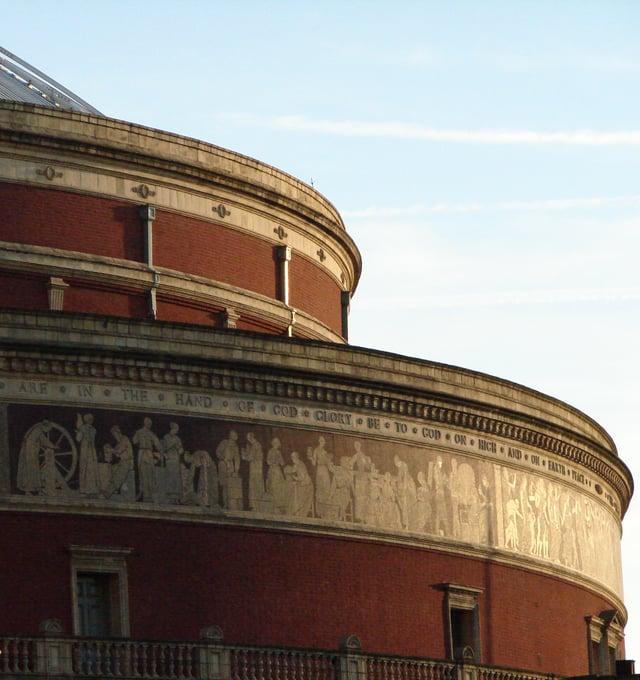
The Triumph of Arts and Sciences
The Hall, a Grade I listed building,[27] is an ellipse in plan, with major and minor axes of 83 m (272 ft) and 72 m (236 ft). The great glass and wrought-iron dome roofing the Hall is 41 m (135 ft) high. The Hall was originally designed with a capacity for 8,000 people and has accommodated as many as 12,000 (although present day safety restrictions mean the maximum permitted capacity is now 5,544 including standing in the Gallery).
Around the outside of the building is a great mosaic frieze, depicting "The Triumph of Arts and Sciences", in reference to the Hall's dedication. Proceeding anti-clockwise from the north side the sixteen subjects of the frieze are:
Various Countries of the World bringing in their Offerings to the Exhibition of 1851
Music
Sculpture
Painting
Princes, Art Patrons and Artists
Workers in Stone
Workers in Wood and Brick
Architecture
The Infancy of the Arts and Sciences
Agriculture
Horticulture and Land Surveying
Astronomy and Navigation
A Group of Philosophers, Sages and Students
Engineering
The Mechanical Powers
Pottery and Glassmaking
Above the frieze is an inscription in 12-inch-high (300 mm) terracotta letters that combines historical fact and Biblical quotations:
This hall was erected for the advancement of the arts and sciences and works of industry of all nations in fulfilment of the intention of Albert Prince Consort. The site was purchased with the proceeds of the Great Exhibition of the year MDCCCLI. The first stone of the Hall was laid by Her Majesty Queen Victoria on the twentieth day of May MDCCCLXVII and it was opened by Her Majesty the Twenty Ninth of March in the year MDCCCLXXI. Thine O Lord is the greatness and the power and the glory and the victory and the majesty. For all that is in the heaven and in the earth is Thine. The wise and their works are in the hand of God. Glory be to God on high and on earth peace.
Below the Arena floor there is room for two 4000 gallon water tanks, which are used for shows that flood the arena like Madame Butterfly.[28]
Events
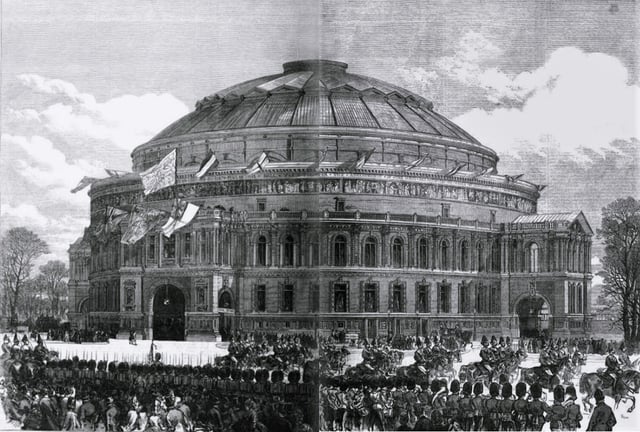
The Hall at the opening ceremony, seen from Kensington Gardens
Many events are promoted by the Hall, whilst since the early 1970s promoter Raymond Gubbay has brought a range of events to the Hall including opera, ballet and classical music. Some events include classical and rock concerts, conferences, banquets, ballroom dancing, poetry recitals, educational talks, motor shows, ballet, opera, film screenings and circus shows. It has hosted many sporting events, including boxing, squash, table tennis, basketball, wrestling including the first Sumo wrestling tournament to be held in London as well as UFC 38 (the first UFC event to be held in the UK), tennis and even a marathon.[32][33] The hall first hosted boxing in 1918, when it hosted a tournament between British and American servicemen. There was a colour bar in place at the Hall, preventing black boxers from fighting there, between 1923 and 1932.[34] Greats of British boxing such as Frank Bruno, Prince Naseem Hamed, Henry Cooper and Lennox Lewis have all appeared at the venue. The hall's storied boxing history was halted in 1999, when a court ordered that boxing and wrestling matches could no longer be held at the RAH. However, in 2011 that decision was overturned, and in a nod to tradition the first boxing card after the lifting of the injunction was a US-UK armed forces competition.[35] In 2019 Nicola Adams and Arely Mucino competed for the WBO Flyweight title and is the first fight for a world title at the venue since Marco Antonio Barrera took on Paul Lloyd in 1999.[36]
On 6 April 1968, the Hall was the host venue for the Eurovision Song Contest which was broadcast in colour for the first time.[37] The first Miss World contest broadcast in colour was also staged at the venue in 1969 and remained at the Hall every year until 1989.
One notable event was a Pink Floyd concert held 26 June 1969, the night they were banned from ever playing at the Hall again after shooting cannons, nailing things to the stage, and having a man in a gorilla suit roam the audience. At one point Rick Wright went to the pipe organ and began to play "The End of the Beginning", the final part of "Saucerful of Secrets", joined by the brass section of the Royal Philharmonic Orchestra (led by the conductor, Norman Smith) and the ladies of the Ealing Central Amateur Choir.[38] A portion of the pipe organ recording is included on Pink Floyd's album The Endless River.[39]
On 18 June 1985, British gothic rock band The Sisters of Mercy recorded their live video album Wake at the Hall. The concert was also the band's last performance with guitarist Wayne Hussey and bassist Craig Adams.
Between 1996 and 2008, the Hall hosted the annual National Television Awards all of which were hosted by Sir Trevor McDonald.[40]
Benefit concerts include the 1997 Music for Montserrat concert, arranged and produced by George Martin, an event which featured artists such as Phil Collins, Mark Knopfler, Sting, Elton John, Eric Clapton and Paul McCartney,[41] and 2012 Sunflower Jam charity concert with Queen guitarist Brian May performing alongside bassist John Paul Jones of Led Zeppelin, drummer Ian Paice of Deep Purple, and vocalists Bruce Dickinson of Iron Maiden and Alice Cooper.[42]
In 2006, Pink Floyd guitarist, David Gilmour performed at the Hall for the first time since Pink Floyd's 1969 ban. He performed at the Hall as part of his On an Island Tour. The shows were filmed and used for the live video release, Remember That Night (2007).
The band The Killers recorded their first live album, Live from the Royal Albert Hall in July 2009.
On 2 October 2011, the Hall staged the 25th anniversary performance of Andrew Lloyd Webber's The Phantom of the Opera, which was broadcast live to cinemas across the world and filmed for DVD.[43] Lloyd Webber, the original London cast including Sarah Brightman and Michael Crawford, and four previous actors of the titular character, among others, were in attendance – Brightman and the previous Phantoms (aside from Crawford) performed an encore.
On 24 September 2012, Classic FM celebrated the 20th anniversary of their launch with a concert at the Hall. The programme featured live performances of works by Handel, Puccini, Rachmaninoff, Parry, Vaughan Williams, Tchaikovsky and Karl Jenkins who conducted his piece The Benedictus from The Armed Man in person.[44]
On 19 November 2012, the Hall hosted the 100th anniversary performance of the Royal Variety Performance, attended by the HM Queen Elizabeth II and HRH Duke of Edinburgh, with boyband One Direction among the performers.[45]
During his Rattle That Lock Tour, David Gilmour performed at the Royal Albert Hall eleven times between September 2015 and September 2016, once in aid of Teenage Cancer Trust.
Kylie Minogue performed at the Royal Albert Hall on 11 December 2015 and 9-10 December 2016 as part of her "A Kylie Christmas" concert series. A live video release of the 11 December 2015 date was released via iTunes and Apple Music on 25 November 2016.
On 3 May 2016, singer-songwriter and Soundgarden vocalist Chris Cornell played at the hall what would become the last UK show of his life as part of his "Higher Truth" European tour. Cornell performed stripped-back acoustic renditions from his back-catalogue to rave reviews, including songs from the likes of Soundgarden, Temple of the Dog, Audioslave and his solo work. Cornell died on 18 May 2017.[46]
On 22 April 2016, British rock band Bring Me The Horizon performed and recorded their Live at the Royal Albert Hall album, with accompaniment from the Parallax Orchestra conducted by Simon Dobson. The Album later released on 2 December 2016 through crowdfunding platform PledgeMusic where all proceeds would be donated to Teenage Cancer Trust.
In 2017, the Hall hosted the 70th British Academy Film Awards, often referred to as the 'BAFTAs', for the first time in 20 years, replacing the Royal Opera House at which the event had been held since 2008.[47]
In 2018, WWE held its second United Kingdom Championship Tournament on 18 and 19 June. In the same year, the world premiere of PlayStation in Concert was organised at the Hall and it featured PlayStation game music from the 90s till today. It was arranged by Jim Fowler and performed by the Royal Philharmonic Orchestra.[48]
Regular events
Royal Choral Society
BBC Proms
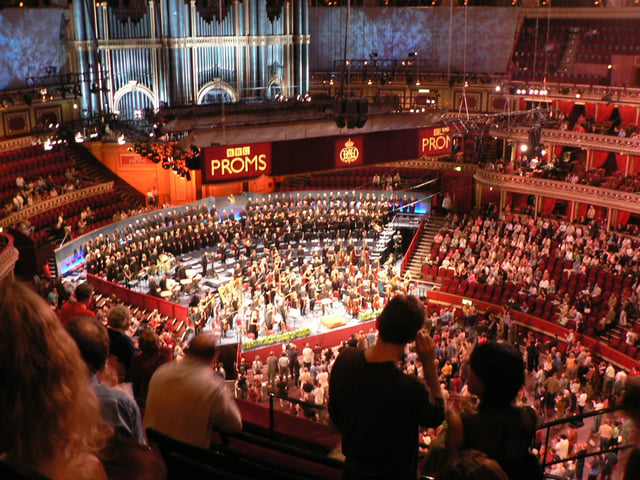
A prom seen from Circle R/S
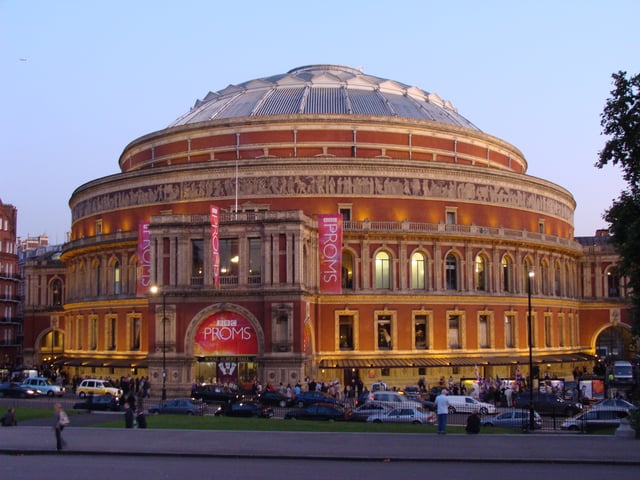
The Hall from Kensington Gardens during the 2008 Proms
The BBC Sir Henry Wood Promenade Concerts, known as "The Proms", is a popular annual eight-week summer season of daily classical music concerts and other events at the Hall. In 1942, following the destruction of the Queen's Hall in an air raid, the Hall was chosen as the new venue for the proms.[51] In 1944 with increased danger to the Hall, part of the proms were held in the Bedford Corn Exchange. Following the end of World War II the proms continued in the Hall and have done so annually every summer since. The event was founded in 1895, and now each season consists of over 70 concerts, in addition to a series of events at other venues across the United Kingdom on the last night. In 2009, the total number of concerts reached 100 for the first time. Jiří Bělohlávek described The Proms as "the world's largest and most democratic musical festival" of all such events in the world of classical music festivals.[52]
Proms (short for promenade concerts) is a term which arose from the original practice of the audience promenading, or strolling, in some areas during the concert. Proms concert-goers, particularly those who stand, are sometimes described as "Promenaders", but are most commonly referred to as "Prommers".[53]
Tennis
Tennis was first played at the Hall in March 1970 and the ATP Champions Tour Masters has been played annually every December since 1997.
Classical Spectacular
Classical Spectacular, a Raymond Gubbay production, has been coming to the Hall since 1988. It combines popular classical music, lights and special effects.
Cirque du Soleil
Cirque du Soleil has performed annually, with a show being staged every January since 2003. Cirque has had to adapted many of their touring shows to perform at the venue, modifying the set, usually built for arenas or big top tents instead. The following shows have played the RAH: Saltimbanco (1996, 1997 and 2003), Alegría (1998, 1999, 2006 and 2007), Dralion (2004 and 2005), Varekai (2008 and 2010), Quidam (2009 and 2014), Totem (2011, 2012 and 2019), Koozå (2013 and 2015) and most recently, Amaluna (2016 and 2017). Amaluna's visit in 2016 marked Cirque's '20 years of Cirque at the Royal Albert Hall' celebration. Cirque's insect themed show, OVO 2018.[54]
Classic Brit Awards
Since 2000, the Classic Brit Awards has been hosted annually in May at the Hall. It is organised by the British Phonographic Industry.
Festival of Remembrance
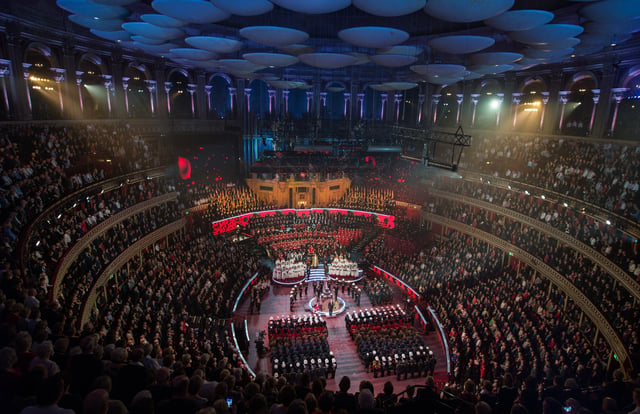
Festival of Remembrance, 2015
The Royal British Legion Festival of Remembrance is held annually the day before Remembrance Sunday.[55]
Institute of Directors
For 60 years the Institute of Directors' Annual Convention has been synonymous with the Hall, although in 2011 and 2012 it was held at indigO2.
English National Ballet
Since 1998 the English National Ballet has had several specially staged arena summer seasons in partnership with the Hall and Raymond Gubbay. These include Strictly Gershwin, June 2008 and 2011, Swan Lake, June 2002, 2004, 2007, 2010 and 2013, Romeo & Juliet (Deane), June 2001 and 2005 and The Sleeping Beauty, April – June 2000.[56]
Teenage Cancer Trust
Starting in the year 2000 the Teenage Cancer Trust has held annual charity concerts (with the exception of 2001). They started as a one off event but have expanded over the years to a week or more of evenings events. Roger Daltrey of the Who has been intimately involved with the planning of the events.[57]
Graduation ceremonies
The Hall is used annually by the neighbouring Imperial College London and the Royal College of Art for graduation ceremonies. For several years the University of London and Kingston University also held its graduation ceremonies at the Hall.
Films, premières and live orchestra screenings
The venue has screened several films since the early silent days. It was the only London venue to show William Fox's The Queen of Sheba in the 1920s.
The Hall has hosted many premières, including the UK première of Fritz Lang's Die Nibelungen, 101 Dalmatians on 4 December 1996, the European première of Spandau Ballet's Soul Boys of the Western World[58] and three James Bond royal world premières; Die Another Day on 18 November 2002 (attended by Queen Elizabeth II and Prince Philip), Skyfall on 23 October 2012 (attended by Charles, Prince of Wales and Camilla, Duchess of Cornwall)[59] and SPECTRE on 26 October 2015 (attended by Prince William, Duke of Cambridge and Catherine, Duchess of Cambridge).[60]
The Hall has curated regular seasons of film-and-live-orchestra screenings since 2009, including the Lord of the Rings trilogy, Gladiator, Star Trek, Star Trek Into Darkness, Interstellar, The Matrix, West Side Story, Breakfast at Tiffany's, Back to the Future, Jaws, Harry Potter and the Chamber of Secrets, and the world première of Titanic Live in Concert.
National Brass Band Championships of Great Britain
The National Brass Band Championships of Great Britain, one of the most prestigious prizes in the annual brass band contesting calendar, holds the Final of the Championship section at the Royal Albert Hall each October[62]
Beyond the main stage
The Hall hosts hundreds of events and activities beyond its main auditorium. There are regular free art exhibitions in the ground floor amphi corridor, which can be viewed when attending events or on dedicated viewing dates. You can take a guided tour of the Hall on most days. The most common is the one-hour Grand Tour which includes most front-of-house areas, the auditorium, the gallery and the Royal Retiring Room. Other tours include Story of the Proms, Behind the Scenes, Inside Out and School tours. Children's events include Storytelling and Music Sessions for 0 – 4-year olds which take place in the Door 9 Porch and Albert's Band sessions in the Elgar Room during school holidays. "Live Music in Verdi" takes place in the Italian restaurant on a Friday night featuring different artists each week. "Late Night Jazz" events in the Elgar Room, generally on a Thursday night, feature cabaret style seating and a relaxed atmosphere with drinks available. "Classical Coffee Mornings" are held on Sundays in the Elgar Room with musicians from the Royal College of Music accompanied with drinks and pastries. Sunday brunch events take place in Verdi Italian restaurant and features different genres of music.[63]
Regular performers
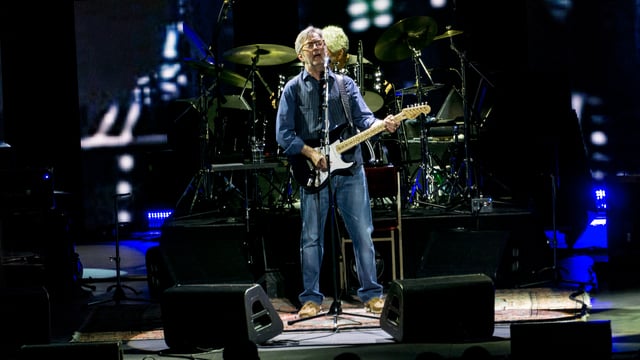
Eric Clapton performing on stage at the Royal Albert Hall in May 2017
Eric Clapton is a regular performer at the Hall. Since 1964, Clapton has performed at the Hall over 200 times, and has stated that performing at the venue is like "playing in my front room".[64][65][66] In December 1964, Clapton made his first appearance at the Hall with the Yardbirds. It was also the venue for his band Cream's farewell concerts in 1968 and reunion shows in 2005. He also instigated the Concert for George, which was held at the Hall on 29 November 2002 to pay tribute to Clapton's lifelong friend, former Beatle George Harrison. Clapton passed 200 shows at the Hall in 2015.[66]
David Gilmour played at the Hall in support of two solo albums, while also releasing a live concert on September 2006 entitled Remember That Night which was recorded during his three nights playing at the Hall for his 2006 On an Island tour. Notable guests were Robert Wyatt and David Bowie (who sang lead for "Arnold Layne" and "Comfortably Numb"). The live concert was televised by BBC One on 9 September 2007 and again on 25 May. Gilmour is set to return to the Hall; having previously played five nights in September 2015, to end his 34-day Rattle That Lock Tour on September 2016 by playing another four nights at the Hall. He also made an appearance on 24 April 2016 as part of the Teenage Cancer Trust event.
Shirley Bassey is one of the Hall's most prolific female headline performers having appeared many times at the Hall since the 1970s. In 2001, she sang "Happy Birthday" for the Duke of Edinburgh's 80th birthday concert. In 2007, she sang at Fashion Rocks in aid of the Prince's Trust. On 30 March 2011, she sang at a gala celebrating the 80th birthday of Mikhail Gorbachev.[67] In May 2011, she performed at the Classic Brit Awards, singing "Goldfinger" in tribute to the recently deceased composer John Barry.[68] On 20 June 2011, she returned and sang "Diamonds Are Forever" and "Goldfinger", accompanied by the Royal Philharmonic Orchestra, as the climax to the memorial concert for Barry.[69]
James Last appeared 90 times at the Hall between 1973 and 2015, making him the most frequent non–British performer to have played the venue.[70]
Education and outreach programme
The hall's education and outreach programme [93] engages more than 200,000 people a year. It includes workshops for local teenagers led by musicians such as Foals, Jake Bugg, Emeli Sandé, Nicola Benedetti, Alison Balsom and First Aid Kit, innovative science and maths lessons, visits to local residential homes from the venue's in-house group, Albert's Band, under the 'Songbook' banner, and the Friendship Matinee: an orchestral concert for community groups, with £5 admission.
Management
The Hall is managed day to day by the chief executive Craig Hassall and five senior executives: the chief operating & financial officer, director of operations, director of business development, director of events and director of external affairs. They are accountable to the Council of the Corporation, which is the Trustee body of the charity. The Council is composed of the annually elected president, currently Ian McCulloch, 18 elected Members (either corporate or individual seat owners) and five Appointed Members, one each from Imperial College London, Royal Commission for the Exhibition of 1851, Department for Culture, Media and Sport, British Museum of Natural History and the Royal College of Music.[71]
Awards
The Hall has won several awards across different categories.
From 1994 to 1998 and in 2003, the Hall won 'International Venue of the Year' in the Pollstar Awards.
In 2004 and 2005, the Hall won 'International Small Venue of the Year' in the Pollstar Awards.
In 2006 to 2010, the Hall won 'International Theatre of the Year' in the Pollstar Awards.[72]
The Hall has won International Live Music Conference Award for 'First Venue to Come into Your Head' in 1998, 2009 and 2013.[73]
From 2008 to 2012, the Hall was voted Superbrands leading Leisure and Entertainment Destination.[74]
On 17 October 2012, the Hall won 'London Live Music Venue of the Year' at the third annual London Lifestyle Awards.[75]
The Hall won the Showcase Award for Teenage Cancer Trust and Event Space of the Year (non-Exhibition), both at the Event Awards 2010.[76]
The Hall has been voted a CoolBrand from 2009 to 2013 in the 'Attractions & The Arts – general' category.[77]
In 2010 and 2011, the Hall won 'Best Venue Teamwork Award' at the Live UK Summit.[78]
The 'Life at the Hall blog won 'Best Venue Blog' at the Prestigious Star Awards in 2012[79] and the Prestigious Star Award Landmark in 2013.[80]
Mislabellings
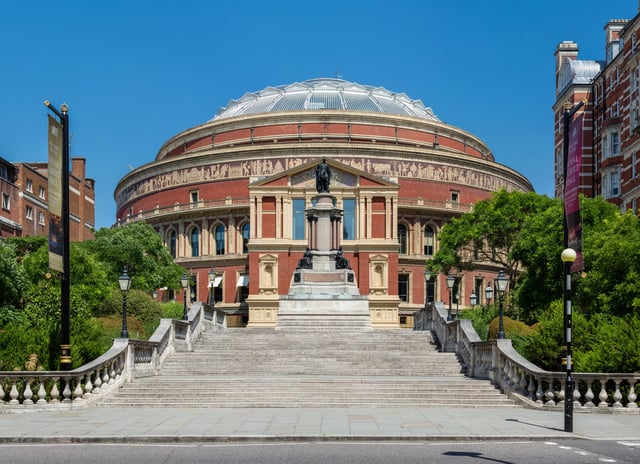
The Hall from Prince Consort Road, showing the South Steps leading up to Door 12
A famous and widely bootlegged concert by Bob Dylan at the Free Trade Hall in Manchester on 17 May 1966 was mistakenly labelled the "Royal Albert Hall Concert". In 1998, Columbia Records released an official recording, The Bootleg Series Vol. 4: Bob Dylan Live 1966, The "Royal Albert Hall" Concert, that maintains the erroneous title, but does include details of the actual location. Recordings from the Royal Albert Hall concerts on 26–27 May 1966 were finally released by the artist in 2016 as The Real Royal Albert Hall 1966 Concert.
Another concert mislabelled as being at the Hall was by Creedence Clearwater Revival. An album by them titled The Royal Albert Hall Concert was released in 1980. When Fantasy Records discovered the show on the album actually took place at the Oakland Coliseum, it retitled the album The Concert.
Pop culture references
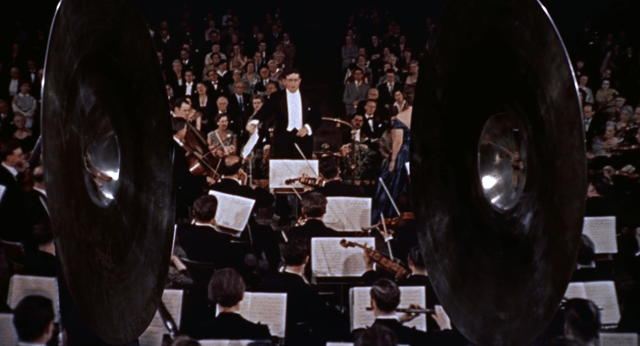
Bernard Herrmann conducting the orchestra in a scene from The Man Who Knew Too Much (1956)
A large mural by Peter Blake, titled Appearing at the Royal Albert Hall, is displayed in the Hall's Café Bar. Unveiled in April 2014, it shows more than 400 famous figures who have appeared on the stage.[81]
In 1955, English film director Alfred Hitchcock filmed the climax of The Man Who Knew Too Much at the Hall.[82] The 15-minute sequence featured James Stewart, Doris Day and composer Bernard Herrmann, and was filmed partly in the Queen's Box. Hitchcock was a long-time patron of the Hall and had already set the finale of his 1927 film, The Ring at the venue, as well as his initial version of The Man Who Knew Too Much, starring Leslie Banks, Edna Best and Peter Lorre.[83]
Other notable films shot at the Hall include Major Barbara, Love Story, The Seventh Veil, The Ipcress File, A Touch of Class, Shine and Spice World.
In the song "A Day in the Life" by the Beatles, the Albert Hall is mentioned. The verse goes as follows:
I read the news today, oh boy four thousand holes in Blackburn, Lancashire and though the holes were rather small they had to count them all now they know how many holes it takes to fill the Albert Hall I'd love to turn you on.
The song "Session Man" by The Kinks references the Hall:
He never will forget at all The day he played at Albert Hall.
In the song "Shame" by Robbie Williams and Gary Barlow, Barlow mentions the Hall in his verse:
I read your mind and tried to call, my tears could fill the Albert Hall.
In some variants of "Hitler Has Only Got One Ball", Hitler's second testicle is mentioned to be in the Hall.
Transport links
See also
Albertopolis
The Great Exhibition
Exhibition Road
Prince Albert
List of concert halls
